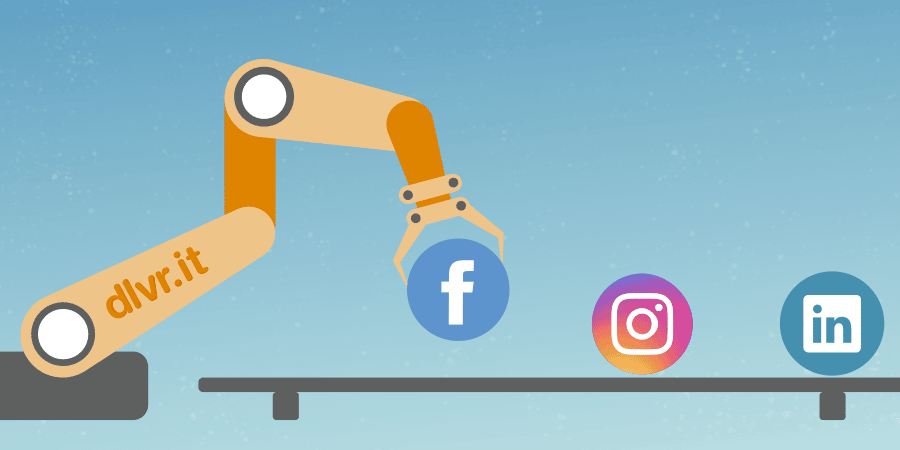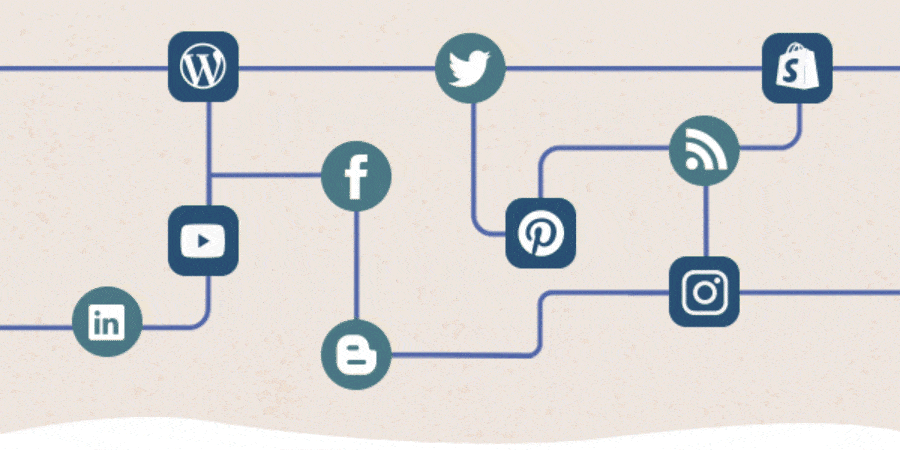
What is Social Media Content?
Social media content refers to the myriad of posts, videos, photos, and articles people share across platforms such as Facebook, Twitter, Instagram, and LinkedIn. Although the emphasis here is on originating unique content, there is also a place for repurposing existing pieces. This holistic approach is integral to a well-rounded content marketing strategy.
Hubspot has revealed that a whopping 85% of marketers see content creation as their primary challenge, and it’s hard to deny the role of content marketing within digital marketing. Content marketing serves as a bridge to connect with potential customers and establish trust among the current clientele.
The Significance of Social Media Content
Why does social media content matter in digital marketing? Because it’s effective for companies of all sizes. Data from Statista shows that 93% of B2C brands harness social media for lead generation. So if your website isn’t attracting the desired traffic, it might be time to revisit your content approach.
Social Media’s Role in Your Business Strategy
Platforms like Facebook, Instagram, Twitter, and YouTube are integral to modern communication. Beyond personal use, they’re a vital resource for information, rivaling traditional media outlets like TV and newspapers. As such, the content you share on these platforms as a business can heavily influence your overall content marketing strategy. But the key is to determine the most impactful kind of content for these platforms.
Strategizing Social Media Content Effectively
The key parts of your strategy are your goals. Your content marketing efforts should have clear objectives that align with your broader marketing goals. By setting goals and observing your target audience’s online behavior and preferences, you can create content that resonates. Consistency, both in terms of regular posting and maintaining a cohesive brand voice, is also essential to build trust with your audience.
Navigating the Social Media Calendar
To seamlessly integrate and execute a robust social media strategy, a content calendar is indispensable. Not only does it provide clarity regarding posting schedules and platform priorities, but it also fosters collaboration. Picking the right platforms that align with your brand’s voice and audience is crucial. The frequency and type of posts can vary based on the platform’s nature and the brand’s objectives.
Managing Your Social Media Content
Organization is the cornerstone of effective social media management. Using folders and tags can streamline your content sorting. Platforms like Facebook and Twitter have also made it increasingly convenient for businesses like yours to foster direct connections with your clientele.
Content Outreach
One of the most potent ways to amplify your brand presence is by consistently sharing original content across various social media channels. Including backlinks and capitalizing on existing content can further bolster this outreach. Hashtags, as simple as they may seem, are instrumental in connecting with a wider audience. Finally, engaging with influencers in your niche can further elevate your brand’s credibility.
Analyzing and Promoting Content
Employing social media analytics tools can give you a comprehensive understanding of campaign success, along with insights into engagement metrics and traffic origins. Moreover, to ascertain the ROI of content marketing initiatives, understanding both quantitative metrics (like bounce rates) and qualitative aspects (like brand loyalty) is essential.

Social Media Content Types That Could Work for Your Brand
- Photos & Images
Photos and images reign supreme in social media. They’re not just pictures—they convey emotions, narrate stories, and can help define your brand. Platforms like Instagram and Pinterest give you a chance to use eloquent images or striking product shots to engage users instantly, making them pause in the middle of endless scrolling. Social media scheduling can be pivotal by allowing you to strategically post visuals during those peak hours when users are most active. This can not only get you more views but it can also boost your chances to engage and interact directly with your base. - Videos
Videos have transformed the way your customers consume content. They let your customers experience your brand and tell your company’s story in a way words often can’t. Platforms like YouTube, TikTok, and Facebook have made videos more accessible, catering to your customers’ diverse preferences, from short clips to extensive vlogs. What’s great about videos is that they’re versatile—you can post how-tos, testimonials, behind-the-scenes peeks, and other formats. But consistency is key to maximizing the potential for videos—and that’s where social media automation shines. When you automate video uploads, your brand can maintain a regular posting rhythm, ensuring that your audience gets a steady stream of engaging content without the hassle of manual uploads. - Blogs & Articles
Long-form content like blogs and articles might seem traditional—but it remains powerful. Blogs and articles delve deep, and offer insights, analyses, and perspectives. On platforms like LinkedIn or Twitter, sharing these pieces establishes your brand’s expertise and thought leadership. But it’s not enough to publish a great article. You can amplify the reach and impact of longer content when you share snippets, quotes, or intriguing questions from an article as teasers on social media. And when you use social media scheduling, you can ensure that these snippets are posted at optimal times, teasing potential readers with insights and driving them to explore the full article.
Beyond the Basics: Diverse Social Media Content Types
Instantaneous Updates: Stories
As social media evolves, Stories retains its unique niche. Initially conceptualized by Snapchat, Stories have become integral to platforms from Instagram to Facebook. These 24-hour content bites offer you a chance to share real-time updates, promotions, or just quirky behind-the-scenes peeks. They are immediate, interactive, and incredibly engaging, and can offer features like polls, quizzes, and Q&A sessions. To maintain a dynamic and fresh Stories feed, you can use social media scheduling. When you plan a consistent stream of Stories, you can keep your audiences engaged and intrigued, ensuring there’s always something new to check out every day.
Deep Dives: Webinars & Live Sessions
In the digital era, the human touch is still irreplaceable. Webinars and live sessions bridge this gap, and can connect your brand directly with your audience. These events let you dive deeply into relevant subjects, product launches, or simply interactive Q&A sessions that get you genuinely engaged with your audience. Promotion is key to successful webinars, so It’s vital to generate buzz and awareness before going live. That’s where social media scheduling is indispensable. By scheduling a series of teaser posts, countdowns, or guest introductions, you can ensure a substantial audience tunes in, maximizing interaction and feedback with your brand.
Conversations Starters: Polls & Surveys
Content isn’t just about talking—it’s about listening too. Polls and surveys serve this exact purpose on social media. They’re more than just tools to gather data. They can be conversation starters, feedback mechanisms, and engagement boosters. By posing relevant questions or seeking opinions on your new products, features, or services you can gain insights while making your audience feel valued and heard. And the dialogue doesn’t need to end once a poll concludes. With social media automation, your brand can preset the sharing of poll results, extending the conversation and ensuring participants stay engaged even post-poll.
Pain Points & How to Overcome Them
The Overwhelming Content Calendar
Every brand, big or small, grapples with the daunting task of maintaining an active social media content calendar. It’s a dynamic puzzle, balancing diverse content types with platform-specific strategies. But it doesn’t have to be a nightmare. With robust social media scheduling tools, you can make this intricate calendar into a well-orchestrated plan. You can plot out your content weeks in advance, creating rhythms and sequences that keep your audience engaged and eager for more. This not only streamlines your posting process, but also allows for strategic content curation.
The Fear of Irrelevance
On social media, today’s trending content can become stale by tomorrow. Brands constantly grapple with the fear of becoming irrelevant or outdated. Thankfully, social media automation tools can offer you a way to stay on top of your content’s relevance. Equipped with comprehensive analytics, the right social media automation tool can give you insights into your content’s performance, audience preferences, and emerging trends. Analyzing this data can help you constantly refine your strategy, ensuring you stay ahead of the curve and resonate with their audience. It’s not just about posting content—it’s about posting content that matters.

Using Automation & Scheduling to Elevate Your Content Strategy
Why Embrace Social Media Automation?
To navigate the digital world with your brand, it pays to be efficient and consistent. Social media automation tools aren’t just about convenience—they’re about optimizing your content strategy. When you streamline your posting process, you can ensure timely distribution of your content across platforms. This not only maintains a consistent brand voice but also lets you spend more time actually creating your content and refining your strategy. By ensuring consistency, social media automation lets you transform your digital presence from sporadic poster to an authoritative voice.
The Power of Scheduling in Social Media
Timing can make or break your content strategy—which is where social media scheduling comes into play. Instead of relying on guesswork or hunches, scheduling tools use data that pinpoints the peak hours when your specific audience is most active. By aligning content posting with these hours, you can optimize engagement, and ensure that the content you crafted doesn’t drown in the vast sea of information. Social media scheduling also offers another perk: mental space. Instead of daily posting stresses, you can plan your posts, creating a cohesive and impactful narrative over weeks or even months.
The Shape of Content & Automation
Digital landscapes are ever-evolving, and in this realm, content remains king—but even a king needs allies. Tools like social media automation and scheduling are these invaluable allies, enhancing the potency of every content type. Whether it’s a fleeting Story, an in-depth webinar, or an insightful poll, each content piece stands to gain from structured scheduling and strategic automation. As brands venture further into the future, this synthesis of content and technology isn’t just an advantage—it’s a necessity.
Social Media Automation Guide
Social Media Automation Tips:
- Schedule posts in advance: Scheduling social media posts ahead of time is an efficient way to ensure consistent communication with your audience. It also reduces the last-minute rush of creating content. By planning ahead, you can align your posts with upcoming promotions, events, or holidays, ensuring that your content is relevant and timely. Moreover, scheduling lets you post during peak engagement times, even if you’re unavailable during those hours, thus increasing the chances of your content being seen.
- Utilize social media management tools: These tools streamline the process of managing multiple accounts across different platforms. They offer features such as centralized dashboards, analytics, and scheduling functionalities. This not only saves time but also allows for a holistic view of your social media performance. By having all your metrics and tools in one place, you can make informed decisions and adjust strategies swiftly, ensuring that you’re always ahead of the curve.
- Regularly post fresh content: Fresh content keeps your audience engaged, updated, and ensures your brand stays top of mind. Regular posting also boosts your visibility in platform algorithms, thus increasing the chances of your content being displayed in your followers’ feeds. It showcases the active presence of your brand, building trust and ensuring that followers have something new and exciting to look forward to, fostering brand loyalty.
- Use analytics to refine strategies: Analytics provide insights into what’s resonating with your audience and what’s not. By regularly reviewing these metrics, you can understand the types of content that drive the most engagement, the best times to post, and demographic data about your followers. This information allows for the optimization of content, ensuring that your social media strategy is data-driven and tailored to the preferences of your audience.
- Engage with followers by responding to comments and messages: Direct engagement builds a personal connection between the brand and its followers. Responding to comments and messages shows followers that their voice is valued. It fosters a sense of community and can lead to increased brand loyalty. Moreover, engagement encourages more interaction, making your posts more visible in platform algorithms.
Pros and Cons of Social Media Automation:
Pros:
- Saves time for marketers: Time is a precious resource. Automation helps marketers streamline repetitive tasks, allowing them to focus on strategic planning and content creation. This increased efficiency can lead to a more cohesive and effective social media strategy, optimizing returns on investment.
- Ensures consistent posting: Consistency in posting reinforces brand presence and trustworthiness. Automation ensures that even during busy periods or unforeseen circumstances, your social media channels remain active, delivering the content your audience expects.
- Centralized dashboard management: Centralized dashboards provide a holistic view of all social media activities. It simplifies the process of tracking performance metrics across platforms, making it easier to spot trends, analyze data, and make informed decisions.
Effective performance tracking: Automated tools often come with built-in analytics, offering detailed insights into post performance, follower demographics, and engagement trends. These insights are invaluable for refining strategies, ensuring that efforts align with audience preferences.
Cons:
- Perceived as impersonal: While automation can streamline processes, over-reliance can make a brand seem distant or robotic. It’s essential to strike a balance to ensure that the personal touch, which fosters genuine connections with followers, isn’t lost.
- Risk of decreased engagement if misused: Automation, if not thoughtfully implemented, can lead to irrelevant or repetitive content, which may bore or annoy followers. Ensuring a mix of automated and real-time posts can help maintain a genuine and engaging online presence.
- Over-automation can lead to account suspension: Some platforms have strict policies against excessive automation, seeing it as spammy behavior. It’s crucial to be aware of these guidelines and ensure that your automation strategies adhere to platform-specific best practices.
FAQs on Social Media Automation:
- Social media can be automated using software, apps, and AI-driven solutions: There’s a broad spectrum of tools available for automating social media tasks, ranging from simple scheduling tools to sophisticated AI-driven platforms. These technologies help brands efficiently manage their online presence, customize content delivery, and even predict trends based on user behavior.
- To automate, decide on platforms, choose a tool, and schedule posts: The first step in automating is to identify which platforms are most relevant to your brand. Once decided, you select a tool that aligns with your needs and start scheduling posts, ensuring a consistent online presence.
- It is generally safe but misuse can lead to decreased engagement: While automation is safe and efficient, it’s essential to use it judiciously. Over-automation or posting irrelevant content can alienate followers and diminish engagement rates. The key is to strike a balance between automation and personal engagement.
- Automation helps in consistent posting and efficient management: Automation ensures that your brand’s voice is consistently heard, even during busy periods. This consistent presence, combined with the organizational benefits of automation tools, ensures an efficient and streamlined social media strategy.
- Costs vary based on the complexity of automation needs: Simple scheduling tools might be available for free or at a low cost. However, comprehensive platforms offering advanced analytics, cross-platform management, and AI-driven insights might come at a premium. It’s essential to assess your brand’s specific needs and budget before choosing a tool.
Getting Started with Social Media Automation:
- Choose platforms based on your audience: Different social media platforms cater to varying demographics and interests. It’s crucial to identify where your target audience spends their time online to ensure that your efforts are directed appropriately. By focusing on the most relevant platforms, you can optimize engagement and returns.
- Decide on content type: Whether it’s videos, images, infographics, or articles, understanding what content resonates with your audience is key. This decision should be based on previous engagement metrics, industry trends, and the nature of the platform itself.
- Set up schedules: Establishing a posting schedule ensures that your audience knows when to expect new content. It also helps in maintaining consistency, a vital factor in retaining and growing your online following.
- Customize messages: While automating, it’s essential to ensure that messages are tailored for each platform and audience segment. Customization adds a personal touch, making followers feel valued and increasing the chances of engagement.
- Monitor and optimize using analytics: Regularly reviewing performance metrics helps in identifying strengths and areas for improvement. Based on these insights, strategies can be refined to ensure that they align with audience preferences and the evolving social media landscape.
- Maintain consistency and engagement: Even with automation, maintaining a consistent voice and engaging with followers is crucial. Regular interactions foster a sense of community, ensuring that your brand remains top of mind.
- Use tools to manage and automate tasks: There are various tools available, each with its own set of features. Whether it’s scheduling, analytics, or cross-platform management, choosing the right tool can greatly enhance your social media strategy’s efficiency.
- Always seek feedback: Feedback, whether positive or constructive, is invaluable. It offers insights into how your audience perceives your brand, helping in refining strategies and ensuring that your efforts align with their expectations.
- Don’t neglect SEO and mobile marketing: While focusing on social media, it’s crucial to integrate SEO practices and optimize for mobile users. This holistic approach ensures that you capture the broadest audience possible, driving traffic and engagement.
